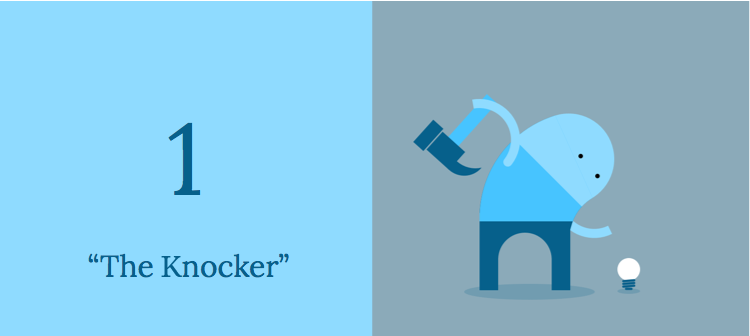The companies we work with are all convinced by the value of UX Design. They appreciate that time and money is required to understand their customers more effectively and that this will allow them to create superior products.
UX Design can become emotional, however, and can sometimes bring out strange behaviours in people. To be frank about it, according to Alan Cooper, the father of the Visual Basic programming language, Design is not so much a design issue as a power struggle.
When this happens, we need to understand what (and who) in the organisation can threaten the change we’ve been asked to implement. We have to listen, explain, reassure and apply liberal doses of diplomacy and empathy.
To help you embrace similar power struggles, we’ve built five personas that you may encounter in the enterprise and some tips to help you get them around to your way of thinking.
 Attitude:
Attitude:
A conservative and negative stakeholder who rejects idea after idea.
Favourite quote:
“This is wrong. We don’t do that here!”
How to deal with them:
UX Design inevitably brings change and the knocker doesn’t like … change. For him, anything that affects the status-quo and his role in the company is a threat. Set up a meeting, listen to his concerns and reassure him – you are here to facilitate his job, not to take it. “Explain to the knocker that by making the product look good, you’ll make him look good”, remarks John Mooney, Xwerx’s Head of UX.

Attitude:
Terrified by doing something stupid or even worse, taking responsibility for it, the “Caveman” disappears into his office (AKA his “cave”), avoiding workshops and meetings.
Favourite quote:
“See you in six months.”
How to deal with them:
Stakeholders (especially those in positions of power) sometimes feel uncomfortable with open design sessions. They feel like they lose their expertise and some of their power in the process. As much as possible, don’t let the cavemen exclude themselves. Explain to them that although they don’t have to be present all the time, their knowledge and their regular input remain essential.
 Attitude:
Attitude:
He’s the invisible executive, “a previously unseen stakeholder who can sneak up at high speed and blow the project out of the water”, writes Kim Goodwin in her book Designing for the Digital Age.
Favourite quote:
“What’s the hell is this?!” (about a project you’ve been working on for 3 months)
How to deal with them:
Deploy your sonar long before the project kick-off. Ask for the company’s organisational chart. With the help of the product owner, identify all the key stakeholders and their potential impact on the project. If a “torpedo” stakeholder escapes your vigilance and comes straight at you, disarm him with a well documented backlog. “Explain where you’ve started, what you’ve done and where you’re expecting to go”, says Murray Nolan, Senior UX Analyst with Xwerx.
Attitude:
Called in sometimes by desperate clients, the hero designer drops in out of the blue, comes up with some beautiful graphics and takes off to rescue the next project.
Favourite quote:
“This is the design I favour. If you don’t like it, go to somebody else.”
How to deal with them:
“Egotistical design satisfies yourself. Empathic design satisfies the user” , writes Jerry Cao from UX Pin. Both the UX team and the client should quickly agree on the fact that hero-based design is far less effective and viable than a collaborative Lean UX based approach. “Instead of relying on a hero designer to devise the best solution from a single point of view, we use rapid experimentation and measurement to learn quickly how well (or not) our ideas meet our goals”, summarises Jeff Gothelf, in the Lean UX manual. User empathy and shared knowledge are the new heroes.
Attitude:
A boss who thinks he should personally solve every problem … because he’s the boss after all.
Favourite quote:
“OK, I’m gonna think about the problem and then come back to you with the idea that solves everything.”
How to deal with them:
The problem with the “Save the World” approach is that it intimidates other stakeholders. Team members become afraid to explore (or kill) solutions. Patiently demonstrate to the Hero Manager that user-centred design is more profitable. It will actually prevent big mistakes and release the pressure on top executives. “It’s not about the best ideas, but the right ideas”, insists Jeff Gothelf . The right ideas are the ones that match both the company’s goals and the user needs. They should be tested and validated.

